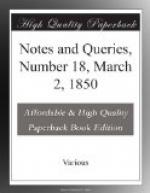“London, August 10th, 1668.
“To Roger Pace, Factor,
&c., for 10 Pieces cont. 746 Ells Fl. at
10 S. Flem. per Ell.
is 373 l. Flem. Exchange at 35 S makes
Sterling Money 213 l. 2s.
10 d.”
The above extract strongly confirms the explanations of the expressions given by your correspondents “Q.Q.” and “Mr. Bolton Corney,” in No. 5. p. 74., as it proves both the necessity and early practice of accurately distinguishing in commercial dealings between English and Flemish methods of reckoning.
E.A.D.
[The following is a curious
illustration of the use of the
phrase.
“A person resident in London is said to have had most of Caxton’s publications. He sent them to Amsterdam for inspection, and, on writing for them, was informed that they had been destroyed by accident. ‘I am very much afraid,’ says Herbert, ’my kind friend received but a Flemish account of his Caxtons.’”—Typ. Antiq., p. 1773.]
La Mer des Histoires.—I find I have a note on that handsome old French work, La Mer des Histoires, which is commonly attributed to Johannes de Columna, Archbishop of Messina; but upon which Francis Douce, while taking notice of its being a translation of the Rudimentum Noviciorum ascribed to Mochartus, observes that it is a different work from the Mare Historiarum of Johannes de Columna. Douce also informs us, that there were several works passing under this title. Columna is mentioned by Genebrard as the author of a book, Cujus titulus est Mater Historiarum. Query? What is known of the work, which is really Columna’s?
John Sansom.
* * * * *
On Passages in Milton
“And every shepherd tells his
tale
Under the hawthorn in the dale.”
Milton’s L’Allegro.
I used to suppose the tale told was a love tale. Now I take it to mean that each shepherd tells the tale, that is, counts the number of his sheep. Is there any doubt on this point?
Milton (Paradise Lost, b. v.), speaks of “silent night with this her solemn bird;” that is, the nightingale. Most readers take “solemn” to mean “pensive;” but I cannot doubt that Milton (who carries Latinism to excess) used it to express habitual, customary, familiar, as in its Latin form sollemnis.
B.H.K.
* * * * *
NOTES ON BOOKS, SALES, CATALOGUES, ETC.
The lovers of accurate and painstaking topography, the students of genealogical history, and, though last not least, those who like to see the writings of Shakspeare, illustrated in a congenial spirit, will read with pleasure the announcement, in our advertising columns, that the fellow-townsmen of Joseph Hunter, the Historian of “Hallamshire” and “The Deanery of Doncaster,” and the Illustrator of the Life and Writings of Shakspeare, have opened a Subscription for the purpose of placing a full-length portrait of that gentleman in the Cutlers’ Hall, Sheffield.




